

MUST SEE Documentary Films. Cultural Innovation. Cultural Innovation. Private Hungary series - films by Peter Forgacs - filmmaker, media artist, documentum film director. Private Hungary Series Private Hungary series films based on home movies from the 1930s and 1960s, which document ordinary lives that were soon to be ruptured by an extraordinary historical trauma that occurs off screen. 14 • The Bishop’s Garden • video, 56'30 min. 13 • A Bibó Reader • 35mm film and video, 69 min. 12 • Kádár’s Kiss • video, 52 min. 11 • Class Lot • video, 52 min. 10 • Free Fall • video, 75 min. 9 • The Land of Nothing • video, 62 min. 8 • The Notes of a Lady • video, 48 min. 7 • Bourgeoisie Dictionary • video, 49 min. 6 • Photographed by László Dudás • video, 45 min. 5 • D-FILM • video, 45 min. 4 • The Diary of Mr.
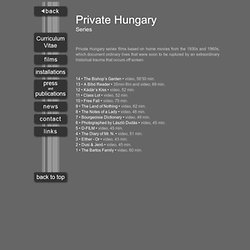
Tous au Larzac ! The Sound of Hitchcock: How the Director Used Sound to Create Atmosphere & Suspense in His Films. Alfred Hitchock is often hailed as one of the great visual artists of the 20th century.

His films are admired for their graphic eloquence — for the power they have, through carefully planned sequences of images, to manipulate the emotions of a viewer. What tends to be overlooked, though, is that Hitchcock applied the same care and foresight in the design of a film’s sound. In these excerpts from Gary Leva’s 2008 documentary The Sound of Hitchcock, some of Hollywood’s top sound designers and filmmakers explain how Hitchcock used sound to create atmosphere and build suspense in classic films like Rear Window, Psycho and The Birds.
In the same way Hitchcock made frequent use of the “subjective camera,” or the point-of-view angle, he also explored the use of subjective sound to communicate the psychological state of his characters. When we reach the night sequence, exaggerate passing car noises when headlights show in her eyes. H/t Aleksandar R. Related content: The essay film. From our August 2013 issue Le camera stylo?
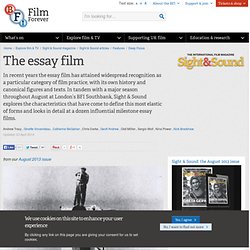
Dziga Vertov’s Man with a Movie Camera (1929) I recently had a heated argument with a cinephile filmmaking friend about Chris Marker’s Sans soleil (1983). Having recently completed her first feature, and with such matters on her mind, my friend contended that the film’s power lay in its combinations of image and sound, irrespective of Marker’s inimitable voiceover narration. “Do you think that people who can’t understand English or French will get nothing out of the film?” To take this film-lovers’ tiff to a more elevated plane, what it suggests is that the essentialist conception of cinema is still present in cinephilic and critical culture, as are the difficulties of containing within it works that disrupt its very fabric. Senses of Cinema. B.
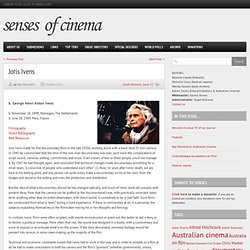
George Henri Anton Ivens b. November 18, 1898, Nijmegen, The Netherlands d. June 28, 1989, Paris, France FilmographySelect BibliographyWeb Resources Joris Ivens made his first documentary films in the late 1920s, working alone with a hand-held 35 mm camera. But the idea of what a documentary should be has changed radically, and much of Ivens’ work sits uneasily with present ideas. In contrast, Ivens’ films were often scripted, with events reconstructed or acted out, the better to tell a story or to deliver a political message. Technical and economic constraints meant that Ivens had to work in this way, and in order to embark on a film at all he had to make concessions to both his camera and the film’s “sponsors” (whether governments, unions, companies or political organisations).
Editing and The Social Network. This week I took in The Social Network – the movie.
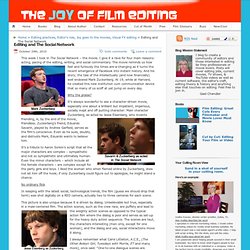
I give it a rave for four main reasons: acting, pacing of the editing, writing, and social commentary. The movie reminds us how fast and furiously the times are-a-changing as it turns the recent emergence of Facebook into instant history. And his story; the tale of the intellectually (and now financially) well endowed Mark Zuckerberg. At 19, while at Harvard, he created this new institution cum communication device that so many of us scoff at yet jump on every day. Why the praise? It’s always wonderful to see a character-driven movie, especially one about a brilliant but impatient, imperious, socially inept and off putting character: Main character Zuckerberg, as acted by Jesse Eisenberg, Film Studies For Free: Open Access Film E-books List. Through the Lens Clearly : Johan van der Keuken. The Last Bolshevik by Chris Marker — Notes from the Era of Imperfect Memory.
It all began in Brussels’ Film Library (“Cinémathèque Royale”) when my friend Jacques Ledoux, the flamboyant conservator, received a package of brand new prints from Moscow.
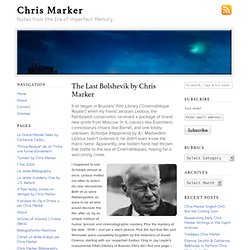
In it, classics like Eisenstein, connoisseurs choice like Barnet, and one totally unknown: Schastye (Happiness) by A.I. Medvedkin. Ledoux hadn’t ordered it, he didn’t even know the man’s name. Apparently, one hidden hand had thrown that bottle to the sea of Cinémathèques, hoping for a welcoming creek. I happened to see Schastye almost at once. Act two: Leipzig Festival, 1967. From that day on, I had the project of doing justice to Medvedkin’s personality and works through a film.
There were the blossoming years of the political cinema in France. But most important (for me, at least) : he was allowed to travel. Well, many things have changed. Another thing has changed: people talk.